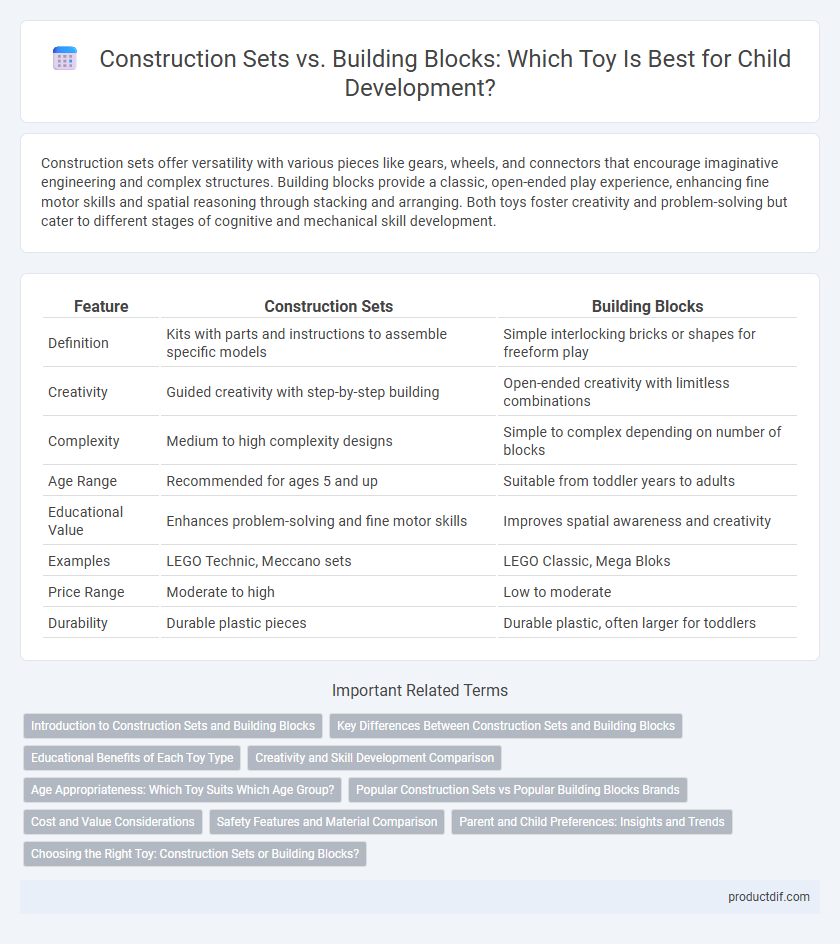Construction sets offer versatility with various pieces like gears, wheels, and connectors that encourage imaginative engineering and complex structures. Building blocks provide a classic, open-ended play experience, enhancing fine motor skills and spatial reasoning through stacking and arranging. Both toys foster creativity and problem-solving but cater to different stages of cognitive and mechanical skill development.
Table of Comparison
| Feature | Construction Sets | Building Blocks |
|---|---|---|
| Definition | Kits with parts and instructions to assemble specific models | Simple interlocking bricks or shapes for freeform play |
| Creativity | Guided creativity with step-by-step building | Open-ended creativity with limitless combinations |
| Complexity | Medium to high complexity designs | Simple to complex depending on number of blocks |
| Age Range | Recommended for ages 5 and up | Suitable from toddler years to adults |
| Educational Value | Enhances problem-solving and fine motor skills | Improves spatial awareness and creativity |
| Examples | LEGO Technic, Meccano sets | LEGO Classic, Mega Bloks |
| Price Range | Moderate to high | Low to moderate |
| Durability | Durable plastic pieces | Durable plastic, often larger for toddlers |
Introduction to Construction Sets and Building Blocks
Construction sets provide children with versatile components like beams, gears, and connectors that encourage complex engineering and creativity. Building blocks, typically uniform in shape and size, foster spatial awareness and fine motor skills through stacking and arranging. Both toys promote cognitive development, but construction sets offer greater opportunities for imaginative mechanical designs.
Key Differences Between Construction Sets and Building Blocks
Construction sets feature specialized pieces such as gears, rods, and connectors designed for creating complex, movable structures, whereas building blocks are simple interlocking bricks intended primarily for stacking and basic shapes. Construction sets encourage fine motor skills and engineering concepts, while building blocks focus on imaginative play and spatial awareness. The level of assembly complexity and educational focus distinguishes construction sets from traditional building blocks.
Educational Benefits of Each Toy Type
Construction sets enhance problem-solving skills by encouraging hands-on experimentation with complex designs, promoting spatial reasoning and engineering concepts. Building blocks foster creativity and fine motor development through open-ended play, supporting early math and language skills as children categorize shapes and colors. Both toys contribute uniquely to cognitive growth by developing critical thinking and imaginative abilities.
Creativity and Skill Development Comparison
Construction sets enhance creativity and skill development by offering complex, interlocking components that encourage problem-solving and fine motor skill refinement. Building blocks provide open-ended play, promoting imaginative thinking and spatial awareness through simple stacking and arranging. Both toys support cognitive growth, but construction sets typically foster advanced engineering skills, while building blocks excel in developing foundational creativity.
Age Appropriateness: Which Toy Suits Which Age Group?
Construction sets are ideal for children aged 5 and up, as they require fine motor skills and cognitive abilities to assemble complex designs. Building blocks are better suited for toddlers and preschoolers, typically ages 1 to 4, promoting basic hand-eye coordination and spatial awareness. Choosing age-appropriate toys ensures safety and fosters developmental milestones effectively.
Popular Construction Sets vs Popular Building Blocks Brands
LEGO dominates the construction sets market with its versatile bricks and themed kits, while Mega Bloks offers large, colorful pieces ideal for younger children. K'NEX provides rod-and-connector sets that encourage complex engineering skills, contrasting with classic wooden building block brands like Melissa & Doug, known for simple, durable shapes. Popular construction sets highlight creativity and interactivity, whereas popular building block brands emphasize open-ended play.
Cost and Value Considerations
Construction sets often offer greater value through versatile components that encourage creativity and fine motor skills development, typically priced higher due to complex parts and branded themes. Building blocks provide a cost-effective alternative with durable, stackable pieces that promote fundamental spatial reasoning and open-ended play, making them accessible for various age groups. Evaluating long-term engagement and educational benefits helps determine which option delivers the best return on investment for children's developmental needs.
Safety Features and Material Comparison
Construction sets often feature interlocking pieces made from durable, non-toxic ABS plastic to ensure safety and withstand repeated use, while building blocks typically use softer, BPA-free materials like foam or wood, reducing choking hazards. Both toys comply with ASTM F963 safety standards, including rigorous testing for small parts, sharp edges, and harmful chemicals. The choice between these materials impacts not only the tactile experience but also the longevity and maintenance of the toy in child-friendly environments.
Parent and Child Preferences: Insights and Trends
Parents often favor construction sets for their educational value and ability to develop fine motor skills, while children tend to prefer building blocks for their simplicity and creativity. Market trends indicate a growing demand for hybrid toys that combine the open-ended play of building blocks with the structured challenges of construction sets. Research shows that parents prioritize developmental benefits, whereas children are motivated by imaginative play and ease of use.
Choosing the Right Toy: Construction Sets or Building Blocks?
Construction sets offer structured play with specific designs and mechanical components, enhancing fine motor skills and engineering concepts, while building blocks provide open-ended creativity and spatial awareness by encouraging freeform construction. Selecting the right toy depends on whether the child prefers guided assembly tasks or imaginative play that fosters problem-solving and innovation. Parents and educators should consider age appropriateness, skill development goals, and the child's interests when choosing between the precision of construction sets or the versatility of building blocks.
Construction sets vs building blocks Infographic

 productdif.com
productdif.com